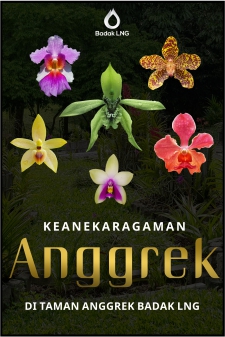The beauty and diversity of orchid plants is the main attraction for botanists, orchid collectors and surround communities. The uniqueness of the flower shape, size, and color that varies, as well as the presence of fragrance on some species are characteristics of orchid plants. Orchid is a plant that belongs to the Orchidaceae family with 43,000 species worldwide and 5,000 of them can be found in Indonesia.

Flower, leaf, fruit, stem, and root morphology are used to identify various types of orchids. Orchid flowers have 5 main parts, namely three sepals (petals), petals (flower crown), stamens, pistils, and ovaries (fruits). The stamens (pollinium) and ovaries (stigma) are present in a columnar structure. The petals of the orchid have three pieces, with details: two have identical shapes, while the other parts are modified into a lip-like shape (labellum). In general, this part of the labellum is considered a distinguishing character between several types of orchids. Orchid leaves are very diverse, ranging from narrow elongated to elongated. Like the general form of monocot plants, orchid leaves do not have leaf veins that form a spreading net, but the leaf bones are parallel to the leaf blade. Leaf thickness also varies from thin to thick fleshy. Orchids have capsule-shaped fruit with very small seeds, yellow to brown in color. Variations of orchid stems are divided into 3 namely slender shapes, fleshy overall, and thickened in certain parts. In addition, some types of orchids have pseudobulbs . In general, orchids have attached roots and aerial roots. Air roots have a spongy texture , are green in color, and play a role in absorbing steam or dew in the air and carrying out photosynthesis. While attached roots function in absorbing nutrients from the humus that accumulates on the surface of the host plant skin, rocks, and soil.
Based on their habitat, orchids are categorized into 4 groups: the epiphytic group (live on other plants without harming the host), the saprophyte group (live on weathered organic matter), the lithophyte group (live attached to rocks), and the terrestrial group (live on the surface of the earth). land). Orchid growth conditions and physiology are influenced by factors, namely: light, temperature, and humidity. Some aspects of light are divided into irradiation time, irradiation intensity, and irradiation quality. The need for light intensity in potted orchids is usually lower than that of ground orchids. Orchids can be found in areas with a temperature of 5-10 o C. In contrast to cultivated orchids, which require a temperature of 15-28o C. In addition, ground orchids are more resistant to hot conditions than pot orchids. Generally, the relative humidity needed by orchid plants during the day is 65%-70%.















